Posted by
ARUN JOHN
on
February 22, 2016

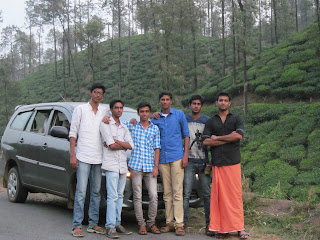 ഒരാഴ്ചക്കാലത്തെ നീണ്ട ചർച്ചകൾക്കൊടുവിൽ ഞങ്ങൾ വീണ്ടും ഒരു യാത്രനിശ്ചയിച്ചു കാരണം പല പല കാരണങ്ങളാൽ ഞങ്ങൾ വളരെ അധികം മാനസിക പിരി മുറുക്കത്തിലായിരുന്നു അതിൽ നിന്നും ഒരു
വിടുതൽ അപ്പോൾ ആവിശ്യമായിരുന്നു . അതിനാൽ തന്നെ ഞാൻ യാത്രയെക്കുറിച്ച് ക്ലാസ്സിൽ അവതരിപ്പിച്ചു എല്ലാരും ഉണ്ടെങ്കിൽ അത് ഒരു ഉത്സവം ആണെല്ലോ എന്നാൽ എല്ലാവരും തന്നെ പലപല കാരണങ്ങൾ നിരത്തി ഒഴിവായി . അവസാനം ഞങ്ങൾ സ്ഥിരം സഞ്ചാരികൾ 5 പേർ മാത്രമായി കുറഞ്ഞു , എങ്കിലും യാത്രാ
ഉപേക്ഷിക്കാൻ ഞങ്ങൾ തയ്യാർ ആയിരുന്നില്ല , അങ്ങനെ ഇരിക്കെ 2 പേർ കൂടി ഞങ്ങളോടൊപ്പം കൂടി അങ്ങനെ ഞങ്ങൾ 7 പേർ (ദീപക്ക് ,ജാക്ക്സൺ ,ജയശങ്കർ ,ജെയിംസ് ,സിജോ ,വിഷ്ണു പിന്നെ ഞാനും ) അടങ്ങുന്ന സംഘം ഇടുക്കി ജില്ലയിലെ പ്രശസ്ത വിനോദസഞ്ചാര കേന്ദ്രങ്ങളിൽ ഒന്നായ രാമക്കൽമേടിനെ
ലക്ഷ്യം വെച്ച് 2015 ഫെബ്രുവരി 19 തിയതി യാത്രാ തിരിക്കാൻ തീരുമാനിച്ചു. ഇന്ന് ആ യാത്രകഴിഞ്ഞിട്ട് കൃത്യം ഒരുവർഷം ആയിരിക്കുന്നു എങ്കിലും നാം സ്നേഹിക്കുന്ന സുഹൃത്തുകൾക്കൊപ്പമുള്ള നല്ല നിമിഷങ്ങൾ യാത്രകൾ ഓർമകൾക്ക് ഒരിക്കലും ഒരുമങ്ങലും സംഭവിക്കില്ല അങ്ങനെ സംഭവിച്ചാൽ
നാം ഒരു നല്ല സുഹൃത്തല്ലായിരുന്നുഎന്ന് കരുതാം ...
ഒരാഴ്ചക്കാലത്തെ നീണ്ട ചർച്ചകൾക്കൊടുവിൽ ഞങ്ങൾ വീണ്ടും ഒരു യാത്രനിശ്ചയിച്ചു കാരണം പല പല കാരണങ്ങളാൽ ഞങ്ങൾ വളരെ അധികം മാനസിക പിരി മുറുക്കത്തിലായിരുന്നു അതിൽ നിന്നും ഒരു
വിടുതൽ അപ്പോൾ ആവിശ്യമായിരുന്നു . അതിനാൽ തന്നെ ഞാൻ യാത്രയെക്കുറിച്ച് ക്ലാസ്സിൽ അവതരിപ്പിച്ചു എല്ലാരും ഉണ്ടെങ്കിൽ അത് ഒരു ഉത്സവം ആണെല്ലോ എന്നാൽ എല്ലാവരും തന്നെ പലപല കാരണങ്ങൾ നിരത്തി ഒഴിവായി . അവസാനം ഞങ്ങൾ സ്ഥിരം സഞ്ചാരികൾ 5 പേർ മാത്രമായി കുറഞ്ഞു , എങ്കിലും യാത്രാ
ഉപേക്ഷിക്കാൻ ഞങ്ങൾ തയ്യാർ ആയിരുന്നില്ല , അങ്ങനെ ഇരിക്കെ 2 പേർ കൂടി ഞങ്ങളോടൊപ്പം കൂടി അങ്ങനെ ഞങ്ങൾ 7 പേർ (ദീപക്ക് ,ജാക്ക്സൺ ,ജയശങ്കർ ,ജെയിംസ് ,സിജോ ,വിഷ്ണു പിന്നെ ഞാനും ) അടങ്ങുന്ന സംഘം ഇടുക്കി ജില്ലയിലെ പ്രശസ്ത വിനോദസഞ്ചാര കേന്ദ്രങ്ങളിൽ ഒന്നായ രാമക്കൽമേടിനെ
ലക്ഷ്യം വെച്ച് 2015 ഫെബ്രുവരി 19 തിയതി യാത്രാ തിരിക്കാൻ തീരുമാനിച്ചു. ഇന്ന് ആ യാത്രകഴിഞ്ഞിട്ട് കൃത്യം ഒരുവർഷം ആയിരിക്കുന്നു എങ്കിലും നാം സ്നേഹിക്കുന്ന സുഹൃത്തുകൾക്കൊപ്പമുള്ള നല്ല നിമിഷങ്ങൾ യാത്രകൾ ഓർമകൾക്ക് ഒരിക്കലും ഒരുമങ്ങലും സംഭവിക്കില്ല അങ്ങനെ സംഭവിച്ചാൽ
നാം ഒരു നല്ല സുഹൃത്തല്ലായിരുന്നുഎന്ന് കരുതാം ...

പാലായിൽ സിജോയുടെ വീട്ടിൽ നിന്നാണ് യാത്രയുടെ തുടക്കം അതുകൊണ്ട് തന്നെ പ്ലാൻ പ്രകാരം രാവിലെ 6 മണിക്ക് തന്നെ ഞങ്ങൾ സിജോയുടെ വീട്ടുകാരെ ഉണർത്തി . അവന്റെ അമ്മ ഞങ്ങൾക്കായ് ചെറിയ കാപ്പി ഒരുക്കിയിരുന്നു . ഞങ്ങൾ അതും അടിച്ചുകൊണ്ടിരിക്കുമ്പോൾ ദീപക്ക് തന്റെ അങ്കിൾനെ
പറ്റിച്ച് പുള്ളിയുടെ വണ്ടിയുമായി എത്തി 6:30 കൂടി ഞങ്ങൾ സിജോയുടെ കുടുംബത്തിന്റെ അനുഗ്രഹത്തോടെ യാത്രാ ആരംഭിച്ചു . ഡ്രൈവിംഗ് എനിക്കൊരു ഭ്രാന്തായിരുന്നതിനാൽ സ്റ്റീയറിംഗ് ഞാൻ യാത്രയിലുടെ നീളം ആർക്കും കൊടുക്കാതെ മുറുക്കെ പിടിച്ചു . വണ്ടിയിൽ കയറിയതും എല്ലാവരുടെയും
മട്ടുമാറി ഉച്ചത്തിൽ പാട്ടും വച്ച് കാറി കൂവി നാടിനെ കിടുക്കി ഞങ്ങൾ കുതിച്ചു . വിഷ്ണു താൻ കൊണ്ടുവന്ന ചോക്ക്ലേറ്റും മറ്റു പലഹാരങ്ങളും ഒക്കെ പതിയെ ഇറക്കാൻ തുടങ്ങി അവന്റെ അച്ഛൻ പണ്ട് പട്ടാളത്തിലായിരുന്നു അതുകൊണ്ട് തന്നെ നല്ല രുചിയുള്ള ഐറ്റംസ് ആയിരുന്നു എല്ലാം .
യാത്രാ അടിച്ചു പൊളിച്ച് മുന്നോട്ട് കരിങ്കുന്നം ,മുട്ടം ,മൂലമറ്റം വഴി ഞങ്ങൾ ഹൈറേഞ്ചിന്റെ ഭംഗിയിലേക്ക് ലയിക്കാൻ ആരംഭിച്ചു ഏകദേശം ഒരു 10 -15 കിലോ മീറ്ററുകൾ ചുരം കയറി കഴിഞ്ഞപ്പോൾ ആണ്. ദീപക്ക് പറഞ്ഞത് " മച്ചാനെ ഡിസൽ അടിക്കാൻ നമ്മൾ മറന്നു " ഞാൻ കിളി പോയപോലെ വണ്ടി
പെട്ടെന്ന് നിർത്തി മീറ്റെറിൽ നോക്കിയപ്പോൾ 2 കട്ടക്ക് മുകളിൽ ഉണ്ട് പക്ഷെ അത് ഇനി എത്ര കിലോമീറ്റർ ഞങ്ങളെ എത്തിക്കും എന്ന് ഞങ്ങൾക്കാർക്കും അറിയില്ലായിരുന്നു . എനിക്ക് സങ്കടവും ഒപ്പം ദേഷ്യവും വന്നു കാരണം പാട്ട് ഉച്ചത്തിൽ ഇടുന്നത് എനിക്ക് ഇഷ്ടമില്ലായിരുന്നു പിന്നെ
അത് കാരണമാണ് പെട്രോൾ അടിക്കുന്ന കാര്യം താനും വിട്ടുപോയത് എന്ന് പറഞ്ഞു ഞാൻ ദേഷ്യപ്പെട്ടു ഒരു വിധത്തിൽ പറഞ്ഞാൽ ഞാൻ കുറ്റം ഒഴിഞ്ഞു . തിരികെ പോയാൽ സമയം പ്രശ്നമാണ് അടുത്ത പമ്പ് ഇനി ചെറു തോണിയിൽ ആണ് ഏകദേശം 35 കിലോ മിറ്റർ സഞ്ചരിക്കേണ്ടി ഇരിക്കുന്നു . മൂലമറ്റം
പോയി അടിച്ച് തിരിച്ചു വരാം എന്നായി ഇനി വണ്ടി തിരിക്കാൻ മാർഗ്ഗമില്ല ഇടുങ്ങിയ വഴി ഒന്ന് ക്രോസ്സ് എടുക്കുമ്പോൾ തുരുതുര വണ്ടിവരും വീണ്ടും ദേഷ്യം വന്ന് ചെല്ലുന്നിടത്തു ചെല്ലട്ടെ എന്ന രിതിയിൽ ഞാൻ വണ്ടി മുന്നോട്ട് പിടിച്ചു , ജെയിംസ് വണ്ടിയുടെ ടാങ്ക് അളവ് നെറ്റിൽ
തപ്പി കട്ടയെണ്ണി പറഞ്ഞു "ഒരു 8 ലിറ്റർ കാണുടാ" എങ്കിൽ പേടിക്കാനില്ല ഞാനും പറഞ്ഞു പിന്നിട് വണ്ടി ഒരു മരിച്ച വീടുപോലെയായി ആരും മിണ്ടാട്ടമില്ല എപ്പോഴും ഫ്യുവൽ മീറ്ററിലെക്ക് നോക്കിയിരിക്കുന്ന 14 കണ്ണുകൾ വണ്ടി കയറുന്നതനുസരിച്ച് മീറ്റർ ക്ലോക്കിലെ സൂചി പോലെ താഴെക്ക്
.
ഞാൻ പറഞ്ഞു ഇത് നമ്മളെ അവിടെ എത്തിക്കുമെന്ന് തോന്നുന്നില്ല . വീണ്ടും ടെൻഷൻ . വഴിയിൽ ഒന്ന് ചോദിക്കാൻ ആരും ഇല്ല അതുവരെ വാഹനങ്ങൾ നിറഞ്ഞ പാതയിൽ മരുന്നിനു പോലും ഒരു വണ്ടി കാണാൻ ഇല്ല . ഇവൻ ചതിച്ചാൽ പിന്നെ തിരിച്ചാൽ മതി ഞാൻ പറഞ്ഞു , കാരണം പ്ലാൻ മൊത്തം തെറ്റും , അങ്ങനെ
നാടുകാണി എത്തി എന്നാൽ ഡിസൽ പ്രശ്നം കാരണം എനിക്ക് അവിടെ ഇറങ്ങാൻ തോന്നിയില്ല , കൂടാതെ നാടുകാണി എന്റെ മനസ്സുമരപ്പിച്ച സ്ഥലമാണ് അതൊരു പഴയ കഥ .
ഞാൻ 7 ൽ പഠിക്കുന്ന സമയം പള്ളിയിൽ നിന്നും കമ്പം - തേനി ടൂർ എല്ലാ വിനോദ സഞ്ചാരികളെ പോലെ ഞങ്ങളും നാടുകാണി വ്യൂ പോയിന്റ് കാണാൻ ഇറങ്ങി ഒരു 1000 അടിയിലേറെ താഴ്ചയാണ് താഴേക്ക് , നല്ല ഒരു പനോരമ വ്യൂ ആണ് , നല്ല മനസിനെ തഴുകുന്ന കാറ്റും പോയിന്റിൽ ഒരു കെട്ടിടം ഉണ്ട് അവിടെ
നിന്നാണ് നാം കാഴ്ചകൾ ആസ്വദിക്കുന്നത് , വ്യൂ പോയിന്റ് കാണാൻ വന്ന ദമ്പതികളും അവരുടെ 2 വയസ്സ് പ്രായം തോന്നിക്കുന്ന മിടുക്കിയായ കുഞ്ഞും . ഭർത്താവ് ഭാര്യയെയും കുഞ്ഞിനേയും ആ വ്യൂ പോയിന്റ്ന്റെ സൈഡിലെ സംരക്ഷണഭിത്തിയോട് ഒപ്പമുള്ള ബഞ്ചിൽ ഇരുത്തി ഫോട്ടോ എടുക്കുന്നു
, കുട്ടിയെ ചിരിപ്പിക്കാൻ ഞങ്ങളും പല കൊഷ്ടികളും കാണിക്കുന്നുണ്ട് . അമ്മയുടെ ശ്രദ്ധഒന്ന് തെറ്റിയപ്പോൾ കുട്ടി ചാരുന്ന ചാരിയിൽ ചവിട്ടി കയറി കൊക്കയിലേക്ക് മറിഞ്ഞു , കുട്ടിയുടെ അച്ഛൻ അലറിക്കൊണ്ട് വന്നു , അമ്മ തല്ക്ഷണം ബോധം കേട്ട് വീണു , ഞാനുൾപ്പെടെ എല്ലാവരും
ഈ കാഴ്ചകൾ കണ്ട് പേടിച്ച് അടിമുടി വിറച്ചു, യാതൊരു പരിചയവും ഇല്ല ആകെ ഓർമ്മ അവളുടെ കൊഞ്ചി ചിരി മാത്രം പിന്നെ കൊഞ്ചിയുള്ള കുറുകുറുപ്പ് ശബ്ദങ്ങളും എന്റെ അടക്കം എല്ലാവരുടെയും കണ്ണുകൾ നിറഞ്ഞു , കുട്ടി എവിടെയെങ്കിലും ഉടക്കിയിരിക്കാൻ സാധ്യത ഉണ്ടെന്നു സെക്യൂരിറ്റി
ഗാർഡ്മാർ പറഞ്ഞു , കുട്ടിയുടെ ജീവനായി വൈദികരും സിസ്റ്റെർമാരും ഉൾപ്പെടെയുള്ള സമൂഹം മുഴുവനും പ്രാർത്ഥനയിൽ മുഴുകി കുട്ടിയുടെ മാതാപിതാക്കളെ ആശുപത്രിയിലേക്ക് മാറ്റി ഒപ്പം . ഫയർ ഫോഴ്സും പോലീസും സ്ഥലത്തെത്തി ആളുകളെ ഒഴിപ്പിച്ചു .ഞങ്ങൾ യാത്രാ മതിയാക്കി തിരികെ പോന്നു
, എന്നാൽ പിറ്റേ ദിവസത്തിലെ പത്രത്തിൽ കുട്ടിയുടെ മരണവാർത്തയാണ് അറിഞ്ഞത് , പിന്നിടുള്ള കുറച്ചു മാസകാലം വ്യൂ പോയിന്റ് സുരക്ഷകുറവ് മൂലം അടച്ചിട്ടിരുന്നു .അതിൽ പിന്നെ വ്യൂ പോയിന്റിനെ ഞാൻ വെറുത്തു പോയി .
പിന്നിട് കാൽവരി മൗണ്ട് എന്ന സ്ഥലം ആയിരുന്നു . പച്ച വിരിച്ച പുൽമേടുകൾക്കിടയിലുടെ മലകയറിയാൽ താഴെ ഇടുക്കി റിസർവോയർ കാഴ്ച വിണ്ടും വീണ്ടും സഞ്ചാരികളെ ഇങ്ങോട്ട് ആകർഷിക്കുന്ന വിധത്തിലുള്ളതാണ് ഒപ്പം വെള്ളത്തിനു നടുവിൽ ദ്വീപ് പോലെ ഓരോ ചെറിയ കുന്നുകളും നല്ലയൊരു കാഴ്ച
സമ്മാനിക്കുന്നു ഒപ്പം താഴ്വാരങ്ങളും വണ്ടി വഴിയിൽ ഇട്ടു കുറെ ദൂരം പൊരി വെയിലത്ത് പൊട്ടി പൊളിഞ്ഞ റോഡിലുടെ സഞ്ചരിക്കേണ്ടി വരുന്നതിനാൽ അവിടേം നിർത്തി എന്നാൽ ഇറങ്ങാതെ വീണ്ടും യാത്രരംഭിച്ചു ,ഞാൻ മുമ്പ് പോയിട്ടുള്ളതിനാൽ അവിടെയും ഇറങ്ങാൻ എനിക്ക് താല്പര്യം ഉണ്ടായിരുന്നില്ല
ഒരു പക്ഷെ ഞാൻ എന്റെ സുഹൃത്തുകളോട് ചെയ്ത ചതിയായി പോയി എന്ന് ഇപ്പോൾ തോന്നുന്നു . കാരണം ആദ്യം ഈ യാത്രാ കാൽവരി മൗണ്ടിൽ അവസാനിപ്പിക്കാൻ ആയിരുന്നു ഉദ്ദേശ്യം പിന്നിടാണ് രാമക്കൽമേടിലെക്ക് മാറിയത് അത് കൊണ്ട് തന്നെ അവരെ അവിടം പരിചയപ്പെടുത്താതെ പോന്നത് അവരോട് ചെയ്ത
വലിയ തെറ്റായിരുന്നു .
ഫ്യുവൽ സൂചി വീണ്ടും തന്നുകൊണ്ടേ ഇരുന്നു അങ്ങനെ കുളമാവിൽ എത്തി ഡാം കഴിഞ്ഞു ഒരു പെട്ടികടയിൽ ചോദിച്ചു പെട്രോൾ പമ്പ് എടുത്തുണ്ടോന്നു ഇനി ചെറുതോണിയിൽ എത്തണം എന്നായിരുന്നു മറുപടി എന്നാൽ മറ്റൊരാൾ അടുത്തു വന്നു രഹസ്യത്തിൽ പറഞ്ഞു "ബസ്സ്റ്റാന്റിന്റെ അവിടെ ഒരു കടയിൽ
ഡിസൽ കിട്ടും " .ഞങ്ങൾ ഒന്നും നോക്കിയില്ല വണ്ടി നേരെ അങ്ങോട്ട് ദീപക്കും ,സിജോയും, ജെയിംസും കൂടെ പോയി കാര്യങ്ങൾ അനേക്ഷിച്ചു വില അല്പ്പം കൂടുതൽ ആണ് ലിറ്ററിന് 60 രൂപാ 8 രൂപാ കൂടുതൽ എന്തെങ്കിലും ആട്ടെ എന്നും പറഞ്ഞ് 5 ലിറ്റർ വാങ്ങി ഒഴിച്ചു , മണ്ണെണ്ണകൂട്ടിട്ടുണ്ടെന്നു
ഞങ്ങൾ ഉറപ്പിച്ചു കാരണം മണ്ണെണ്ണയുടെ മണം നല്ല പോലെ ഉണ്ടായിരുന്നു , നമ്മൾ ആവശ്യക്കാർ ആയി പോയില്ലേ എന്ത് പറയാൻ ..
വീണ്ടും സമാധാനപരമായ യാത്രാ കുറച്ചു പോയി വെറുതെ ഒരു ഉൾവഴിയിൽ കൂടി സഞ്ചരിച്ചു , അതൊരു പക്ഷെ നല്ല ഒരു തീരുമാനം ആയിരുന്നു , കാരണം ബൈബിളിൽ പറയുന്ന പോലെ താഴ്വാരങ്ങളിൽ ആടുകളും കാലികളും മേയുന്നു ഒപ്പം ഇടയന്മാരും പഴയകാല ഓർമ്മകളെ ഉണർത്തുന്ന വിധത്തിലുള്ള കാഴ്ചകൾ
ആയിരുന്നു അവ വീണ്ടും മുന്നോട്ടു നിങ്ങിയപ്പോൾ ഞങ്ങൾ ചെന്ന് നിന്നത് ഇരുവശവും ആഴമേറിയ കൊക്കെകൾ തീർത്തും ആരെയും പേടിപ്പെടുത്തുന്ന രംഗം , അവിടെ ഞങ്ങൾ ഒരു മരത്തണലിൽ വണ്ടിയിട്ട് അവിടെ ഒരു 30 മിനിറ്റോളം ചിലവഴിച്ചു പിന്നിട് വീണ്ടും യാത്രാ പഴയ റൂട്ടിലേക്ക് .,
പിന്നിട് ഇടുക്കി ഹിൽ വ്യൂ പാർക്കിലെക്കായിരുന്നു , ടിക്കറ്റും എടുത്ത് കുത്തനെയുള്ള വഴികൾ നടന്നു കയറി ഇടുക്കി ഡാമിനെ അങ്ങ് ദൂരെ കാണാം. കലിപൂണ്ടു ഓളം തല്ലുന്ന ജല പ്രളയത്തെ വളരെ നിസാരം എന്ന രിതിയിൽ പിടിച്ചു നിർത്തി അഹങ്കാരത്തോടെ തലയുയർത്തി നിൽക്കുന്ന വളഞ്ഞ ഒരു
ഡാം . അവിടെ അത് ചുമ്മാ നിന്ന് കാണുന്നത് പോലും നമ്മൾ മലയാളികൾക്ക് ഒരു അഭിമാനവും അഹങ്കാരവും ആണെന്ന് വേണേൽ പറയാം. വെയിലിന്റെ ചൂട് ഞങ്ങളെ വീണ്ടും പാർക്കിന്റെ നിറുകയിൽ കയറാൻ തോന്നിപ്പിച്ചില്ല തിരിച്ചിറങ്ങി യാത്രാ തുടർന്നു ..
ചെറുതോണിയിൽ എത്തി ഡിസലും നിറച്ചു ഇടുക്കി ഡാമിന്റെ അടിയോരം പറ്റി കട്ടപ്പന -പാമ്പാടും പാറ വഴി രാമക്കൽ മേടിന്റെ അടിത്തട്ടിലേക്ക് അവിടെയും ഇവിടെയും കറങ്ങാതെ നില്ക്കുന്ന കാറ്റാടി യാന്ത്രങ്ങൾ ചൂണ്ടികാട്ടി ജാക്ക്സൺ പുച്ഛത്തോടെ പറഞ്ഞു ഇത് കാണാൻ ആണോ ഇവിടേം വരെ വന്നത്
. വീണ്ടും വണ്ടി മുന്നോട്ടു പോകും തോറും കാറ്റാടികൾ കൂടി വന്നു മുളങ്കാടുകള്ക്കും കുറ്റി ചെടികള്ക്കും ഇടയിലൂടെ കടന്നു പോകുന്ന കാട്ടുപാതയാണ് രാമക്കല്മേടിലേക്കുള്ള പ്രധാന വഴി. ഈ യാത്രതന്നെ അവിടേക്കെത്തുന്ന സഞ്ചാരികള്ക്ക് നല്കുന്ന അനുഭൂതി ചെറുതല്ല. പൊടി നിറഞ്ഞ
പാതയിൽ കൂടെയുള്ള ചെറിയ ഓഫ് റോഡ് ഡ്രൈവ് രസം തരുന്ന വിധത്തിലയിരുന്നു ഏകദേശം 12 മണിയോട് കൂടി ഞങ്ങൾ രാമക്കൽ മേടിന്റെ നെറുകയിൽ വണ്ടി അടുപ്പിച്ച് ടിക്കറ്റ് എടുത്ത് അകത്തേക്ക് നടന്നു .
രാമക്കൽ മേടിനെ കുറിച്ച് പറയാൻ ഏറെയുണ്ട് .സമുദ്രനിരപ്പിൽ നിന്ന് 1100 മീറ്റർ ഉയരത്തിൽ പശ്ചിമ ഘട്ടത്തിലാണ് രാമക്കൽ മെട് നിലകൊള്ളുന്നത്.. നിലക്കാത്ത കാറ്റിനാൽ സമ്പന്നമാണ് ഇവിടം. ഇന്ത്യയിൽ തന്നെ ഏറ്റവുംമധികം
കാറ്റുവിശുന്ന ഒരു പ്രദേശം കൂടിയാണ് മണിക്കൂറിൽ ശരാശരി 30 മുതൽ 35 കിലോ മിറ്റർ വേഗത്തിലാണ് കാറ്റ് നമ്മെ തഴുകി പോകുന്നത് ചിലപ്പോൾ അത് 100 മുകളിലും പോകാറുണ്ട് . നോക്കിയാല് കണ്ണെത്താ ദൂരത്തോളം പരന്നുകടിക്കുന്ന തമിഴ്നാടിന്റെ ഭാഗമായ കൃഷിയിടങ്ങളും അവിടവിടെ സ്ഥിതി
ചെയ്യുന്ന കൊച്ചുകൊച്ചു പട്ടണങ്ങളും കാറ്റാടി പാടങ്ങളും സഞ്ചാരികള്ക്ക് സമ്മാനിക്കുന്നത് മറ്റെവിടെയും കിട്ടാത്ത കാഴ്ച സൗന്ദര്യമാണ്.കുറച്ച് സാഹിത്യത്തിൽ പാറഞ്ഞാൽ കാറ്റിന്റെ തിരമാലകൾ അലയടിക്കുന്ന ഒരു അദൃശ്യസാഗരത്തിലേക്ക് നോക്കുന്നപോലെ അതുതന്നെയാണ് ഇവിടേക്ക്
സഞ്ചാരികളെ ആകർഷിക്കുന്നതും .തേനിയും തേവാരവും കോമ്പയും ചിന്നമന്നൂരുമൊക്കെ രമാക്കല്മേടില് നിന്നും നോക്കുന്നവര്ക്ക് ദൃശ്യമാകും.
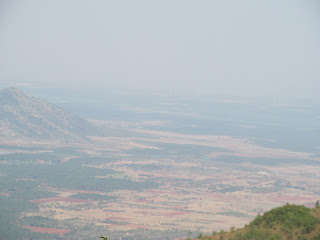 ഒന്നിനുമുകളില് ഒന്നായി അടുക്കിവെച്ച പാറകളാണ് മറ്റൊരത്ഭുത കാഴ്ചയാണ്. ഒരു തള്ള് തള്ളിയാല് അത് മറിഞ്ഞ് അഗാധതയിലേക്ക് പതിക്കുമെന്ന് തോന്നുന്ന തരത്തിലാണ് പ്രകൃതി അതില് വികൃതി കാട്ടിയിരിക്കുന്നത്. 300 മിറ്ററിൽ
ഏറെ ഉയരത്തിൽ നില്ക്കുന്ന ഈ പാറക്കെട്ടുകളിൽ സാഹസികത ഇഷ്ടപ്പെടുന്നവർക്ക് കയറി കൂടുതൽ ഉയരത്തിലുള്ള ഭംഗി ആസ്വദിക്കാവുന്നതാണ് .മേഘങ്ങൾക്കൊപ്പം നമ്മളും നിൽക്കുന്ന അത്രയും രസം വേറെ ഉണ്ടോ ? രാമക്കല്മേടില് നിന്നും തമിഴ്നാട്ടിലേക്ക് ഒരു കാടുപ്പാതയും കാണാന് സാധിക്കും.
പണ്ടുകാലങ്ങളില് ഇവിടേക്ക് തമിഴ്നാട്ടില് നിന്നും തലച്ചുമടായും കഴുതപ്പുറത്തും ഭക്ഷ്യസാധനങ്ങള് കൊണ്ടുവന്നത് ഈ വഴിയായിരുന്നു. രാമക്കല്മേടില് വൈകുന്നേരങ്ങള് ചെലവിടുന്നവര്ക്ക് നേക്കെത്താദൂരത്ത് തമിഴ്നാട്ടിലെ ചെറു പട്ടണങ്ങള് ദീപ പ്രഭയില് കുളിച്ചു നില്ക്കുന്ന
കാഴ്ച കാണാനാകും. വെയിൽ കഠിനമായിരുന്നു അതിനാൽ തന്നെ സാഹസികത പിന്നൊരിക്കൽ ആകാം എന്ന് വിചാരിച്ചു ഒരു മരത്തണലിൽകൂടി എങ്കിലും കാറ്റ് ചൂട് തോന്നിപ്പിക്കുന്നില്ല ഒപ്പം മടുക്കുന്നുമില്ല .
ഒന്നിനുമുകളില് ഒന്നായി അടുക്കിവെച്ച പാറകളാണ് മറ്റൊരത്ഭുത കാഴ്ചയാണ്. ഒരു തള്ള് തള്ളിയാല് അത് മറിഞ്ഞ് അഗാധതയിലേക്ക് പതിക്കുമെന്ന് തോന്നുന്ന തരത്തിലാണ് പ്രകൃതി അതില് വികൃതി കാട്ടിയിരിക്കുന്നത്. 300 മിറ്ററിൽ
ഏറെ ഉയരത്തിൽ നില്ക്കുന്ന ഈ പാറക്കെട്ടുകളിൽ സാഹസികത ഇഷ്ടപ്പെടുന്നവർക്ക് കയറി കൂടുതൽ ഉയരത്തിലുള്ള ഭംഗി ആസ്വദിക്കാവുന്നതാണ് .മേഘങ്ങൾക്കൊപ്പം നമ്മളും നിൽക്കുന്ന അത്രയും രസം വേറെ ഉണ്ടോ ? രാമക്കല്മേടില് നിന്നും തമിഴ്നാട്ടിലേക്ക് ഒരു കാടുപ്പാതയും കാണാന് സാധിക്കും.
പണ്ടുകാലങ്ങളില് ഇവിടേക്ക് തമിഴ്നാട്ടില് നിന്നും തലച്ചുമടായും കഴുതപ്പുറത്തും ഭക്ഷ്യസാധനങ്ങള് കൊണ്ടുവന്നത് ഈ വഴിയായിരുന്നു. രാമക്കല്മേടില് വൈകുന്നേരങ്ങള് ചെലവിടുന്നവര്ക്ക് നേക്കെത്താദൂരത്ത് തമിഴ്നാട്ടിലെ ചെറു പട്ടണങ്ങള് ദീപ പ്രഭയില് കുളിച്ചു നില്ക്കുന്ന
കാഴ്ച കാണാനാകും. വെയിൽ കഠിനമായിരുന്നു അതിനാൽ തന്നെ സാഹസികത പിന്നൊരിക്കൽ ആകാം എന്ന് വിചാരിച്ചു ഒരു മരത്തണലിൽകൂടി എങ്കിലും കാറ്റ് ചൂട് തോന്നിപ്പിക്കുന്നില്ല ഒപ്പം മടുക്കുന്നുമില്ല .
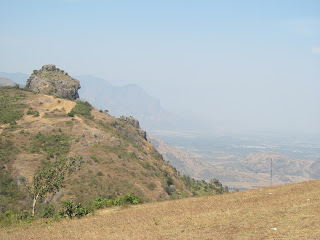 മറ്റൊരു പ്രധാന ആകർഷണം കേരളത്തിലെ ഏറ്റവും വലിയ ട്വിന് സ്റ്റാച്യുകളിൽ ഒന്നായ കുറവന്റെയും കുറത്തിയുടെയും മനോഹര ശില്പ്പമുള്ളത്ഇവിടെയാണ് കുറത്തിക്കൊപ്പം പൂവന്കോഴിയുമായിരിക്കുന്ന കുറവനും സമീപത്ത് കുട്ടിയുമടക്കമുള്ള
ശില്പ്പം സംഘകാലത്തിന്റെ ചരിത്രാവശിഷ്ടങ്ങളാണ്.വരച്ചു കാട്ടുന്നത് .രാമക്കല്മേടിന്റെ സ്ഥലനാമവുമായോ ഹൈറേഞ്ചിന്റെ ചരിത്രവുമായോ ഈ കുറവർ കുടുംബത്തിന് ബന്ധമൊന്നുമില്ല. മന്നാന്, മുതുവാന്, മലയരയര്, ഉള്ളാടര്, ഊരാളി, പളിയന്, മലപ്പുലയന് എന്നിങ്ങനെ ഏഴോളം വരുന്ന
ആദിവാസി വിഭാഗങ്ങളാണ് ഹൈറേഞ്ചിലെ ആദിമ മനുഷ്യർ .
മറ്റൊരു പ്രധാന ആകർഷണം കേരളത്തിലെ ഏറ്റവും വലിയ ട്വിന് സ്റ്റാച്യുകളിൽ ഒന്നായ കുറവന്റെയും കുറത്തിയുടെയും മനോഹര ശില്പ്പമുള്ളത്ഇവിടെയാണ് കുറത്തിക്കൊപ്പം പൂവന്കോഴിയുമായിരിക്കുന്ന കുറവനും സമീപത്ത് കുട്ടിയുമടക്കമുള്ള
ശില്പ്പം സംഘകാലത്തിന്റെ ചരിത്രാവശിഷ്ടങ്ങളാണ്.വരച്ചു കാട്ടുന്നത് .രാമക്കല്മേടിന്റെ സ്ഥലനാമവുമായോ ഹൈറേഞ്ചിന്റെ ചരിത്രവുമായോ ഈ കുറവർ കുടുംബത്തിന് ബന്ധമൊന്നുമില്ല. മന്നാന്, മുതുവാന്, മലയരയര്, ഉള്ളാടര്, ഊരാളി, പളിയന്, മലപ്പുലയന് എന്നിങ്ങനെ ഏഴോളം വരുന്ന
ആദിവാസി വിഭാഗങ്ങളാണ് ഹൈറേഞ്ചിലെ ആദിമ മനുഷ്യർ .
അവരുടെ ചരിത്രവുമായോ പുരാവൃത്തവുമായോ ഉടൽ രൂപങ്ങളുമായോ പൊരുത്തപ്പെടാതെ, മലമ്പുഴ യക്ഷിപോലെ, ശംഖുമുഖത്തെ മത്സ്യ കന്യക പോലെ ഒന്ന്. ഒരു കലാസൃഷ്ടി. മലമുടികളുടെ ഉയരത്തെ രൂപംകൊണ്ട് അതിലംഘിച്ച് അതങ്ങനെ നിലകൊള്ളുന്നു. സി.ബി ജിനനാണ് ശില്പി .
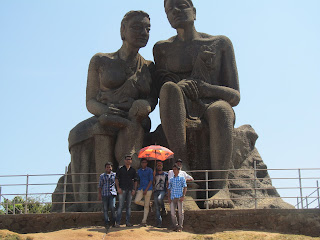 രാമക്കൽമേടിന്റെ പേരിനു പുറകിൽ ഒന്നിലധികം ഐതിക്യങ്ങൾ ഒളിഞ്ഞു കിടക്കുന്നു എന്നാണ് പറയപ്പെടുന്നത് .ത്രേതായുഗകാലത്ത് സീതയെ അന്വേഷിച്ച് ശ്രീലങ്കയ്ക്കുള്ള ശ്രീരാമന്റെ യാത്രാമധ്യേ ഈ മേടിൽ ഇറങ്ങിയെന്നും . സേതുബന്ധനത്തിനായ്
രാമേശ്വരം തിരഞ്ഞെടുത്തത് ഇവിടെ വെച്ചായിരുന്നുവെന്നും . ശ്രീരാമന്റെ പാദങ്ങൾ പതിഞ്ഞതിനാലാണ് ഈ സ്ഥലത്തതിന് രാമക്കൽമേട് എന്ന പേര് വന്നത് എന്നതു കൂടാതെ മേടിന് മുകളിലെ 'കല്ലുമ്മേൽ കല്ലു'മായി ബന്ധപ്പെട്ടതാണ് മറ്റൊന്ന് . വനവാസകാലത്ത് പാണ്ഡവൻമാർ ഇവിടെ വന്നപ്പോൾ, ദ്രൗപതിക്ക്
മുറുക്കാൻ ഇടിച്ചു കൊടുക്കാൻ ഭീമസേനൻ ഉപയോഗിച്ചതാണ് ആ കല്ല് എന്നാണ് മറ്റൊന്ന് . എന്നാല് സീതാരാമൻമ്മരുമായി സ്ഥലനാമപരമായി രാമക്കൽമേടിന് ബന്ധമൊന്നുമില്ല. രാമം എന്നാൽ കുരങ്ങ് എന്നാണ് അർത്ഥം . രാമൻമാർ ധാരാളം നിരനിരയായിരിക്കുന്ന പാറക്കെട്ടുകൾ നിറഞ്ഞ കുന്നായതിനാലാണ്
രാമക്കൽമേട് എന്ന പേര് വന്നതെന്നാണ് ഒരുല്പത്തികഥ. ഇനിയും ഉണ്ട് അനവധി കഥകൾ .
രാമക്കൽമേടിന്റെ പേരിനു പുറകിൽ ഒന്നിലധികം ഐതിക്യങ്ങൾ ഒളിഞ്ഞു കിടക്കുന്നു എന്നാണ് പറയപ്പെടുന്നത് .ത്രേതായുഗകാലത്ത് സീതയെ അന്വേഷിച്ച് ശ്രീലങ്കയ്ക്കുള്ള ശ്രീരാമന്റെ യാത്രാമധ്യേ ഈ മേടിൽ ഇറങ്ങിയെന്നും . സേതുബന്ധനത്തിനായ്
രാമേശ്വരം തിരഞ്ഞെടുത്തത് ഇവിടെ വെച്ചായിരുന്നുവെന്നും . ശ്രീരാമന്റെ പാദങ്ങൾ പതിഞ്ഞതിനാലാണ് ഈ സ്ഥലത്തതിന് രാമക്കൽമേട് എന്ന പേര് വന്നത് എന്നതു കൂടാതെ മേടിന് മുകളിലെ 'കല്ലുമ്മേൽ കല്ലു'മായി ബന്ധപ്പെട്ടതാണ് മറ്റൊന്ന് . വനവാസകാലത്ത് പാണ്ഡവൻമാർ ഇവിടെ വന്നപ്പോൾ, ദ്രൗപതിക്ക്
മുറുക്കാൻ ഇടിച്ചു കൊടുക്കാൻ ഭീമസേനൻ ഉപയോഗിച്ചതാണ് ആ കല്ല് എന്നാണ് മറ്റൊന്ന് . എന്നാല് സീതാരാമൻമ്മരുമായി സ്ഥലനാമപരമായി രാമക്കൽമേടിന് ബന്ധമൊന്നുമില്ല. രാമം എന്നാൽ കുരങ്ങ് എന്നാണ് അർത്ഥം . രാമൻമാർ ധാരാളം നിരനിരയായിരിക്കുന്ന പാറക്കെട്ടുകൾ നിറഞ്ഞ കുന്നായതിനാലാണ്
രാമക്കൽമേട് എന്ന പേര് വന്നതെന്നാണ് ഒരുല്പത്തികഥ. ഇനിയും ഉണ്ട് അനവധി കഥകൾ .
ഞങ്ങൾക്കൊപ്പം അവിടെ മൂന്നാറിൽ നിന്നും എത്തിയ കുറെ വികൃതി രാമൻമാരും ചന്ദ്രികമാരും ഉണ്ടായിരുന്നു എല്ലാവരും ഒന്നാം ക്ലാസ്സിലും രണ്ടിലും പഠിക്കുന്നു ഒപ്പം 3 ടീച്ചർമാരും 1 സാറും ഉണ്ട് , ആശാൻമാർ കുന്നിൻ പുറത്ത് പലപല കളികളിൽ ഏർപ്പെട്ടിരിക്കുന്നു വെയിലൊന്നും അവർക്ക്
ഒരു പ്രശ്നമല്ല , ഞങ്ങൾ അവരുടെ കളിയും കണ്ടും കളിപ്പിച്ചും ഞങ്ങളുടെ ബാല്യകാല സ്മരണകൾ അയവിറക്കിക്കൊണ്ടിരുന്നു , ചിലർ ഞങ്ങളെ പേടിപ്പെടുത്തുന്ന വിധത്തിൽ കൊക്കയുടെ സൈഡിലുടെ ഓടുന്നു , ടീച്ചർമാർ ദൂരെ ഒരു മരച്ചോട്ടിൽ മറ്റു പരിപാടികളിൽ ഏർപ്പെട്ടിരിക്കുന്നു ,. ടീച്ചർമ്മാരുടെ
അശ്രദ്ധയെ കുറ്റപ്പെടുത്തി അവരോട് വാക്കുവാദത്തിനു പോകാൻ തുടങ്ങിയ ദീപക്കിനെയും ജാക്ക്സനെയും ഞങ്ങൾ തടഞ്ഞു . ഉച്ചയുണിനായി പൊരിവെയിലിൽ പുൽമേട്ടിൽ കുട്ടികളെ നിരത്തിയിരുത്തിയത് ഞങ്ങളെ എല്ലാവരെയും ഒന്നുപോലെ ദേഷ്യം പിടിപ്പിച്ചു കാരണം തണൽ മരങ്ങളും വിശ്രമകൂടാരങ്ങളും
ഉണ്ടായിരിക്കെ കുട്ടികളെ ഇങ്ങനെ ദ്രോഹിക്കുന്നത് വളരെയധികം മനസിനെ വേദനിപ്പിക്കുന്നതയിരുന്നു .അവരുടെ സ്വന്തം കുട്ടികൾ ആണെങ്കിൽ ഇങ്ങനെ ചെയ്യുവോ ? ഞങ്ങൾ സംശയിച്ചു . അവിടെയുംഞങ്ങൾ മാന്യതമാനിച്ചു സ്ഥലം കാലിയാക്കാൻ തീരുമാനിച്ചു അവിടെ 2 കുതിരകൾ നിന്നിരുന്നു 2ഉം വെയിലിൽ
വാടിയ കണ്ണുമായി നില്ക്കുന്നു ,നിഷ്കളങ്ക ഭാവത്തോടെയുള്ള അവയുടെ നോട്ടം വേദനാജനകമാണ് . പുറത്തു കയറി വീണ്ടും അതുംങ്ങളെ ബുദ്ധിമുട്ടിക്കാൻ തോന്നിയില്ല ഞങ്ങൾ ഒരു ഐസ്ക്രീമും കഴിച്ച് രാമക്കൽമേടിനോട് വിടപറഞ്ഞു .
 |
| കുട്ടികളെ ഉച്ചഭക്ഷണത്തിന് പൊരിവെയിലിൽ ഇരുത്തിയിരിക്കുന്നത് കാണാം |
2:30 കൂടി തിരിച്ചു കട്ടപ്പനയിൽ എത്തി ഭക്ഷണവും കഴിച്ച് അഞ്ചുരുളി ലക്ഷ്യമാക്കി നീങ്ങി . ഏലപ്പാറ വഴി 9 കിലോ മിറ്റർ ദൂരം മാത്രമേ കട്ടപ്പനയിൽ നിന്നൊള്ളൂ. കക്കാട്ടുകടയില് നിന്ന്.തിരിഞ്ഞാൽ 3 കിലോമീറ്റർ . ചെറിയ
ഇടുങ്ങിയ കാട്ടുവഴികൾ താണ്ടി ഞങ്ങൾ അഞ്ചുരുളിയിൽ എത്തിച്ചേർന്നു ,. ഇടുക്കി ഡാമിന്റെ ആരംഭം ഇവിടെ നിന്നാണ്. ഇരട്ടയാർ ഡാമിൽ നിന്നും ഇടുക്കിയിലേക്ക് ടണൽ വഴി ഒഴുക്കുന്ന നയനാനന്ദകരമായ കാഴ്ചയാണ് ഇവിടുത്തെ പ്രധാന ആകർഷണം . 2 കി.മി. ഓളം നീളമാണ് ഇതിനുള്ളത്. അഞ്ചു മലകളാൽ
ചുറ്റപ്പെട്ടതിനാൽ ആവാം ഈ പേരുവിളിക്കപ്പെട്ടത് . ഞങ്ങൾ തടാകത്തിന്റെ കരയിലേക്കാണ് ആദ്യം ഇറങ്ങിയത് വിഷ്ണു ചാടാൻ റെഡി ആയിരുന്നു ജാക്സനും ജെയിംസും വെള്ളത്തിൽ ഇറങ്ങിയാൽ കയറി പോരാൻ വലിയ പ്രയാസമാണ് , ഇടുക്കി ഡാമിന്റെ ഭാഗം ആയതിനാൽ മുതലകളെ പേടിച്ചാണ് ആരും ഇറങ്ങാത്തത്
, പിന്നിട് പ്രധാന കാഴ്ച വിസ്മയമായ തുരങ്കത്തിലേക്ക് നീങ്ങി , വളരെ വലുപ്പത്തിൽ പാറ തുളച്ചുനിർമ്മിച്ചതാണ് മറ്റെഅറ്റം ഒരു പൊട്ടുപോലെ കാണാം ,തുരങ്കത്തിൽ നല്ല എക്കോയാണ് ചിലർ തങ്ങൾക്ക് പ്രിയപ്പെട്ടവരുടെ പേരുകൾ ഉറക്കെ വിളിച്ചു കൂവി അത് റെക്കോർഡ് ചെയ്തു . നല്ല
രസമാണ് അങ്ങേ അറ്റംവരെ ആ പേരുകൾ ചെന്നിരിക്കാം ... എന്തായാലും ബ്രിട്ടീഷുകാരുടെ സൃഷ്ടി ആയിരിക്കാം ഇത് തുരങ്കത്തിലൂടെ കുറച്ച് നടന്നു പിന്നിട് ഒക്സിജൻ കുറവ് പോലെ തോന്നി തിരികെ പോന്നു ധാരാളം പാമ്പുകൾ ഇതിനുള്ളിൽ ഉണ്ടെന്നാണ് കേട്ടുകേൾവി എന്നാൽ ഒന്നിനെയും കണ്ടില്ല
എന്നത് ഭാഗ്യം , ഐസ് വാട്ടർ പോലെ തണുത്തു മരവിച്ച വെള്ളം നമ്മെ തഴുകി ഒഴുകുമ്പോൾ ശരിരത്തിനും മനസിനും എങ്ങുന്നില്ലാത്ത ഉണർവും കുളിരും . നല്ല ഇരുട്ടാണ് ഉള്ളിൽ ...
., 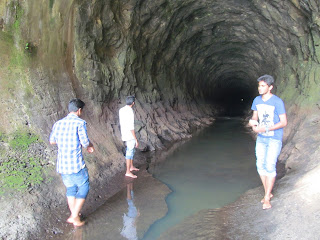 തിരിച്ചു ഇറങ്ങിയപ്പോൾ അതാ ദീപക്കിന് പരിചയമുള്ള ഒരു മുഖം ദീപക്കിന്റെ മറ്റൊരു അങ്കിൾ ആണ് ഭാര്യാ വീട്ടിൽ വന്നപ്പോൾ ചുമ്മാ പിള്ളേരെയും ആയി ഇറങ്ങിയതാണ് . തൂക്കുപ്പാലം കണ്ടിട്ട് പോയ മതിയെന്ന അങ്കിളിന്റെ നിർബന്ധം
. തിരികെ പോരനൊരുങ്ങിയ ഞങ്ങളെ അങ്ങോട്ട് തിരിച്ചു എന്നാൽ നിരാശയായിരുന്നു ഫലം റോഡ് പണി നടക്കുന്നതിനാൽ വഴിക്ക് കുറുകെ കല്ലുകൾ ഇറക്കിയിരിക്കുന്നു , നിരത്താനുള്ള വണ്ടിയെ കുറച്ചു നേരം കത്തിരുന്നെങ്കിലും കാണാത്തതിൽ സമയം കാത്തുനിൽക്കത്തതിനെ തുടർന്ന് ഞങ്ങൾ വാഗമൺ വഴി
തിരികെ പോന്നു 8 മണിയോട് കൂടി വാഗമൺ എത്തി ,പകലിന്റെ സൗന്ദര്യം രാത്രിയിൽ വാഗമണ്ണിൽ കണ്ടില്ല 9 മണിയോട് കൂടി യാത്രാ തുടങ്ങിയ സിജോയുടെ വീട്ടിൽ തന്നെഅണഞ്ഞു ***
തിരിച്ചു ഇറങ്ങിയപ്പോൾ അതാ ദീപക്കിന് പരിചയമുള്ള ഒരു മുഖം ദീപക്കിന്റെ മറ്റൊരു അങ്കിൾ ആണ് ഭാര്യാ വീട്ടിൽ വന്നപ്പോൾ ചുമ്മാ പിള്ളേരെയും ആയി ഇറങ്ങിയതാണ് . തൂക്കുപ്പാലം കണ്ടിട്ട് പോയ മതിയെന്ന അങ്കിളിന്റെ നിർബന്ധം
. തിരികെ പോരനൊരുങ്ങിയ ഞങ്ങളെ അങ്ങോട്ട് തിരിച്ചു എന്നാൽ നിരാശയായിരുന്നു ഫലം റോഡ് പണി നടക്കുന്നതിനാൽ വഴിക്ക് കുറുകെ കല്ലുകൾ ഇറക്കിയിരിക്കുന്നു , നിരത്താനുള്ള വണ്ടിയെ കുറച്ചു നേരം കത്തിരുന്നെങ്കിലും കാണാത്തതിൽ സമയം കാത്തുനിൽക്കത്തതിനെ തുടർന്ന് ഞങ്ങൾ വാഗമൺ വഴി
തിരികെ പോന്നു 8 മണിയോട് കൂടി വാഗമൺ എത്തി ,പകലിന്റെ സൗന്ദര്യം രാത്രിയിൽ വാഗമണ്ണിൽ കണ്ടില്ല 9 മണിയോട് കൂടി യാത്രാ തുടങ്ങിയ സിജോയുടെ വീട്ടിൽ തന്നെഅണഞ്ഞു ***
... അരുൺ ...
|
Posted by
Pranay Rai
on
February 21, 2016

1) The difference between a Leopard, a Jaguar, a Cheetah and a Panther. Are they all the same as the people tend to think?
-Certainly No, they aren’t the same. Here’s the difference:
Leopard:
Scientific Name: Panthera Pardus;
The leopard is the smallest of the four ‘big cats’ in the ‘Panthera’ family, along with tigers, lions and jaguars.
Differentiating Characteristic: They look similar to the jaguar, however they are smaller and lighter and the fur patterning is slightly different; on a leopard, the ‘rosettes’ (circular markings) are smaller and are more closely spaced, and don’t usually have
the black spots in the center of the rosettes like jaguars do. Leopards rosette pattern and overall color can vary slightly, however, depending on where they live.
Jaguar:
Scientific Name: Panthera Onca;
Differentiating Characteristics: The jaguar is often confused with the leopard due to the markings on the coat. Jaguars are, however, heavier, larger and sturdier than leopards, and the ‘rosettes’ on their patterning are larger, less closely packed, and usually
have black dots in the centers.
Cheetah:
Scientific Name: Accinonyx Jubatus
Differentiating Characteristic: The fur is short and coarse, and has a pattern of evenly spaced black spots.
Panther:
There is no actual species called the panther, however ‘panther’ is a name given to either leopards or jaguars which are black in color due to an excess of the dark pigment melanin. They can also be referred to as melanistic leopards/melanistic jaguars.
The coat is almost completely black, however sometimes the rosette markings can just be seen if you look closely
2) What is the difference between a Crocodile and an Alligator?
A Crocodile has a V-shaped snout while an Alligator has a U-shaped, rounder snout.
When a Crocodile closes its mouth, the fourth tooth in its lower jaw can still be seen, which is not seen in an Alligator.
3) Difference between a Tortoise and a Turtle.
Tortoise:
Dwells well on land;
Heavy, dome shaped shells;
Short and sturdy feet with bent legs.
Turtle:
Dwells well in the water;
Mostly flat, streamlined, light-weight shells;
Webbed feet with long claws.
|
Posted by
Pranay Rai
on
February 21, 2016

Keoladeo National Park, Bharatpur, also known as Ghana Bird Sanctuary, is one of the best bird sanctuaries in the world.
The name Keoladeo comes from the temple of Lord Shiva which is located in that area. And Ghana means ‘dense’. The sanctuary is a heaven for animal lovers and bird watchers.
The park is open throughout the year, although, the best experience of watching the migratory birds and pythons, comes in the winter months from mid October to February. December is considered to be the ideal month for bird watching as a plethora of birds can
be seen.
The park allows the visitors to hire bicycles and rickshaws for the tour.
A narrow road, fit for cycling, winds its way throughout the park surrounded by dense green forest.
A sweet chirping of various birds can be heard in the magnificence of the forest. A large variety of birds can be seen basking in the sun, feeding the chicks, soaring high in the sky, plunging into the water bodies for fishes.
Along with the umpteen birds, mammals such as the Spotted Deer and Nilgais can be spotted.
On our visit, in September this year, a male Spotted Deer stag was seen crossing the road. It stood there for a few seconds, flaunting its majestic body, and then disappeared in the bushes.
A Nilgai was spotted running through the swamp waters, creating a sudden ruckus which alarmed the birds around the place. The then serene scene was filled with boisterous chirping and splashing of water in no time.
Frogs can be heard croaking around the muddy and still water of the marsh. Snails can be easily and abundantly found in the bogs.
The best thing about the park is the independency for the tourists. There are no limitations in the safari timings and zones. A person can go anywhere and can stay in the park until the sun sets. Guides, possessing an ample amount of knowledge about the flora
and fauna and about the park, can be hired accordingly by paying an extra amount along with the tickets and bicycle charge.
The park is a bliss for the wildlife enthusiasts and is one of the must visit places in Rajasthan.
|
Posted by
Pranay Rai
on
February 21, 2016

Keoladeo National Park, Bharatpur, also known as Ghana Bird Sanctuary, is one of the best bird sanctuaries in the world.
The name Keoladeo comes from the temple of Lord Shiva which is located in that area. And Ghana means ‘dense’. The sanctuary is a heaven for animal lovers and bird watchers.
The park is open throughout the year, although, the best experience of watching the migratory birds and pythons, comes in the winter months from mid October to February. December is considered to be the ideal month for bird watching as a plethora of birds can
be seen.
The park allows the visitors to hire bicycles and rickshaws for the tour.
A narrow road, fit for cycling, winds its way throughout the park surrounded by dense green forest.
A sweet chirping of various birds can be heard in the magnificence of the forest. A large variety of birds can be seen basking in the sun, feeding the chicks, soaring high in the sky, plunging into the water bodies for fishes.
Along with the umpteen birds, mammals such as the Spotted Deer and Nilgais can be spotted.
On our visit, in September this year, a male Spotted Deer stag was seen crossing the road. It stood there for a few seconds, flaunting its majestic body, and then disappeared in the bushes.
A Nilgai was spotted running through the swamp waters, creating a sudden ruckus which alarmed the birds around the place. The then serene scene was filled with boisterous chirping and splashing of water in no time.
Frogs can be heard croaking around the muddy and still water of the marsh. Snails can be easily and abundantly found in the bogs.
The best thing about the park is the independency for the tourists. There are no limitations in the safari timings and zones. A person can go anywhere and can stay in the park until the sun sets. Guides, possessing an ample amount of knowledge about the flora
and fauna and about the park, can be hired accordingly by paying an extra amount along with the tickets and bicycle charge.
The park is a bliss for the wildlife enthusiasts and is one of the must visit places in Rajasthan.
|
Posted by
Susan Sharma
on
January 23, 2016

Exhibition of Ikebana by Ohara school from Gurgaon
Ohara School emphasizes seasonal qualities, natural growth processes, and the beauty of natural environments.


Ohara school of Ikebana specialises in bringing nature scenes to homes. With most people in urban areas living in multi -story flats with limited living space, it is all but easy to forget the beauty and happiness that natural landscapes provide.


Learning Ikebana or flower arrangement where only real flowers and drift wood, seeds etc are used is a release for the creative aspirations of many a housewife. Collecting the materials which bring in harmony, which express the beauty of colors and arranging
them as per the requirements of Ikebana is an art as is seen from the many arrangements pictured here.


Materials are arranged as if they are piled up in low flat containers with a wide surface area of water. It includes the Color Scheme Moribana, which expresses beauty of color, and the Landscape Moribana, in which the beauty of natural scenery is represented.
Traditional Method
This is a technique to express the beauty of scenery using limited materials, and arranging methods prescribed for these materials while observing their natural growth. This is a type of arrangement in which natural landscapes are represented in the limited
space of flower containers.
Realistic Method
This is a technique to express scenic beauty by understanding the natural growth, environment, and the seasonal aspect of the material, and by mixing in the subjectivity and impressions of the arranger.




|
Posted by
Vijay Kumar
on
January 23, 2016
I want to upload some photos . I believe it will be useful to you. - vijayakumar
|
Posted by
Uday
on
January 17, 2016

Corbett National Park was the first protected area to be declared as a Tiger Reserve. Named after the legendary hunter of man eating tigers Jim Corbett the region abounds with rich wilderness. The park is now a hub
of tiger tourism and birding in India.
Situated at a height of six hundred MSL it is also known as the foothills of Himalayas. The towering mountains can be seen while on a game ride in the park. Divided into six zones namely:
Bijarani
Dhela
Jhirna
Dhikala
Sonanadi
Durga Devi
The entry has to be booked in advance using the online facility or through a tour operator. All zones are equally good for a safari but I personally rate Dhikala and Bijarani as best. In Dhikala one can see plenty of
birds apart from the tiger, wild elephant, sloth bear, gharial and marsh crocodile. For a game round Dhikala a stay in the complex is necessary. The booking is done in advance due to the heavy rush. Bijarani is good for tigers and other mammals found in the
reserve.
There are more than five hundred avian species to be sighted here. Many of these are altitude migrants while some arrive from far but local migrants and residents abound.
The region is having affinity with Indo-China hence one can see the goral as well on the mountain slopes. Hod deer is another species worth looking for. There are more than six hundred wild elephants which cover an
extensive area.
The reserve is top rated by bird watchers in Northern India. The best season is of course in winters. For tigers summers is the best season but they are visible throughout the year. The destination has more than 200
tigers hence the impressive sightings.
Joy rides on elephant back are also available which are conducted by the forest department in the zones. In the buffer region at Ramnagar one can hire privately managed elephants for ride in the forests adjacent to
the Ramganga River.
For safari in other zones stay at Ramnagar is the best as there are many hotels and guest houses. One can avail any kind of accommodation depending upon one's budget.
Corbett is accessible from Delhi by road and a visit is often organized in a package tour. The itinerary often contains a visit to Bharatpur, Nainital and Corbett. While the first two are for bird watching the latter
is for
tiger tours apart from bird watching.
The destination is also accessible by train from Lucknow and New Delhi. Due to extreme cold one needs warm clothing and a cozy place to stay. If you are not in a package tour then hire a birding guide to hence the checklist.
|
Posted by
samanvay bhutani
on
December 28, 2015

Dear Readers,
Thank you for turning up and reading my article.
My love for wildlife was merely an accident. I along with a few friends just landed up at Ranthambore National Park, Sawai Madhopur Distt. Rajasthan India. This was a very unusual trip for me since i have always loved luxury and relaxing holidays, but little
did i knew that once i enter the forest lovingly called as Ranthambore Tiger Reserve, I instantly felt a strong connect with this place.
I hardly had any interest in wildlife and was doing absolutely nothing except for looking at a few deer's roam around and a few birds here and there and then to my surprise i was asked to sit back tight as the gypsy caught up with unusual adrenaline and it
seemed like i was on the last ride of my life.
For good two minutes i was rather angry for being there all covered by dust and splashes but than it all came to a halt and in a split second it changed my outlook for wildlife forever, A gigantic roar from across the bushes was enough to send chills down
my spine,lips sealed i looked to the other side of waters(Rajbagh Lake) and it was a sight to behold and treasure. A female tigress(T-19) aka Krishna showed up frowning towards the maddened rush of gypsy and canters, As a few hundred eyes lit up seeing the
beast walk around the bushes. It was an amazing thing to experience but what happened next was a mere dream.
The light started to fade away and as the tigress walked, from the bushes i heard another unusual sound and yes there it was a dream for many wildlife lovers, She was followed by 3 beautiful cubs. What more could you ask for, I stood admiring the beautiful
relationship of the mother and her 3 adorable cubs who walked beside her in a straight line unaware of surroundings and soon disappeared in the habitat i now know as Malik Talab at Zone no. 3 of RNP.
Amidst the hustle bustle of my daily life coming into a jungle where i could literally hear myself breath,inhaling that fresh crisp air that brought peace to my mind, a feeling of a different world, a glimpse of a relation of a mother and baby which wasn't
too different from real life human relations and that was the point RNP became a addiction and a wonderful 2nd home to me, I visit almost every month familiar to every Zone(1-10) and very familiar to almost all named tigers, May it be courageous story of T-16(Machli)
or the Ravishing T-24(Ustaad) or the hunkT-72(Sultan) and many family like names to me now.
Do love Nature, Protect Wildlife, Respect Animals and pledge to help make earth a better place for all to live in..!
Love
Samanvay
|
Posted by
samanvay bhutani
on
December 28, 2015

Dear Readers,
Thank you for turning up and reading my article.
My love for wildlife was merely an accident. I along with a few friends just landed up at Ranthambore National Park, Sawai Madhopur Distt. Rajasthan India. This was a very unusual trip for me since i have always loved luxury and relaxing holidays, but little
did i knew that once i enter the forest we lovingly call as Ranthambore Tiger Reserve, I went all Gaga over this place.
I hardly knew what i was doing there except for looking at a few deer roam around and a few birds here and there and then to my surprise i was asked to sit back tight as the gypsy caught with unusual adrenaline and flew it seemed like i was on the last ride
of my life.
For good two minutes i was rather angry for being there all covered by dust and splashes but than it all came to a halt and in a split second it changed my outlook for wildlife forever, A gigantic roar from across the bushes was enough to send chill down to
the spine and lips sealed i looked to the other side of waters(Rajbagh Lake) and it was a sight to behold and treasure a female tigress(T-19) aka Krishna showed up frowning towards the maddened rush of gypsy and canters, As a few hundred eyes were lit up seeing
the beast walk around the bushes and what happened next was a mere dream.
The light started to fade away and as the tigress walked away followed by 3 beautiful cubs and what more could you ask for. The light almost giving up as i stood admiring the beautiful relationship of the mother and her 3 adorable cubs who walked beside her
in a straight line unaware of surroundings and soon disappeared in the habitat i now know as Malik Talab at Zone no. 3 of RNP.
Amidst the hustle bustle of my daily life coming into a jungle where i could literally hear myself breath,inhaling that fresh crisp air that brought peace to my mind, a feeling of a different world, a glimpse of a relation of a mother and baby which wasn't
too different from real life human relations and that was the point RNP became a addiction and a wonderful 2nd home to me, I visit almost every month familiar to every Zone(1-10) and very familiar to almost all named tigers, May it be courageous story of T-16(Machli)
or the Ravishing T-24(Ustaad) or the hunkT-72(Sultan) and many family like names to me now.
Do love Nature, Protect Wildlife, Respect Animals and pledge to help make earth a better place for all to live in..!
Love
Samanvay
|
Posted by
satheesh
on
November 17, 2015
I have visited many wildlife sanctuaries accord south india .And iam deeply interested in wildlife photography which always emphasizes me with much eager and makes me learn in each and every picture.Since it is my first blog , i continue further in my
coming blogs .
|